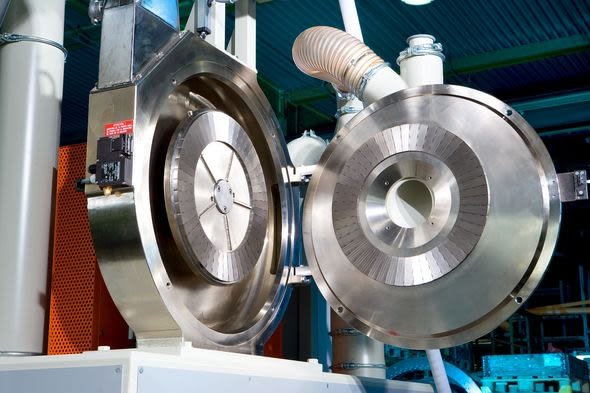This is even more the case because the whole system built around the PolyGrinder is extremely com-pact. A feeder dispenses the granules evenly into the mill, a blower downstream transfers the ground pow-der over an extremely short distance into the cyclone separator, a rotary air lock conveys the final product into a container. The automatic control of the complete system is done via an integrated control cabinet. All accessories required for operation and material changeover are positioned at a comfortable working height. The compact design of the entire high output system not only saves valuable floor space, but also it contributes very short tubes how far the material moves very short ways to fast and easy cleaning with low material loss.

Bulk weight, particle size the fineness, particle shape and flowability of the milled material can have a significant impact on the quality of the final product. Masterbatch producers, for example, look for a large particle surface area with a narrow particle size distribution to get good binding with additives and to ensure an even distribution of the masterbatch in the final product.
Applications such as rotational molding may appear undemanding, but if one is capable of producing powder with a precisely specified particle size distribution and special geometry – and so generate very high fluidity - it may be possible to reduce the amount of material needed for a special part, without altering its mechanical properties. And these savings have a direct effect on the product costs - or the yield per part - in the overall cost calculation.
In both cases, and especially in masterbatch and compound production, developers are plagued with un-certainty about the performance of the powder, the quality achievable in the product, and the cost of grind-ing (the cooling required, part wear, and so on). For such cases, it makes sense to start trials in the world's largest pilot plant for size-reduction technology, at the Pallmann Group’s headquarters in Zweibrücken, Germany, to clarify in advance just what is technically and economically feasible - experience shows that is more than the average material developer suspects.
A variety of factors affect the cost of fine grinding: the absence of refrigerant, the quick and safe cleaning, as well as the durability and low maintenance with minimal downtime, all have a big effect on keeping costs down. Contract millers needing to process a wide range of materials in rapid succession can especially benefit from this. In addition, the ability to accurately influence, size, surface structure, bulk density and other parameters, provide further competitive advantages.



